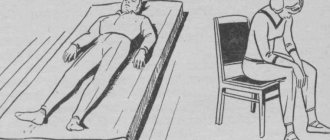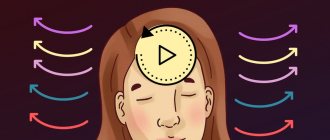Psychological therapy has a variety of techniques and techniques, some of which, when used skillfully, can achieve amazing results. Autogenic training is one of these techniques that involves psychological self-regulation and self-hypnosis. Autogenic training has a certain connection with hypnosis, but differs from it in that the “patient” is not a passive object of influence, but actively practices psychological influence on himself.
Autogenic training: what is it?
Wikipedia defines autogenic training quite abstrusely. It says that autogenic training is “a psychological technique aimed at restoring the dynamic balance of the homeostatic mechanisms of the human body that are disturbed as a result of stress.” It needs to be defined more simply and clearly.
Autogenic training is a technique that achieves control over certain body functions that are initially involuntary. These are, in particular, psychological and mental functions, so autogenic training is often used to relieve internal tension, normalize and improve mood, and overcome psychological problems. At the same time, an important part of autogenic training is muscle relaxation, which is carried out at the first stage.
Autogenic training is a fairly simple method, so it can be mastered by most people. It is believed that the autogenic training technique was developed at the beginning of the twentieth century by Johann Schultz, a German psychiatrist and psychotherapist. In the early stages of his scientific career, he conducted hypnosis sessions and then developed a more advanced system in which the patient was given a more active role. Schultz is a fairly prominent scientist of his time, one of those specialists who integrated psychotherapy into medical practice, and generally made psychology a full-fledged science. Of course, Schultz’s personality also had its dark side: he was one of the Nazi ideologists and tried to interpret racial and mental “inferiority” from a medical perspective. In Nazi Germany, Schultz organized mass persecution of homosexuals, and also tried to “cure” them using savage methods; those who could not be “cured” were sent to a concentration camp by Schultz. Nevertheless, the autogenic training method outlined by Schultz is widely used today throughout the world.
However, Schultz did not develop his system from scratch. First, he examined the work of contemporary psychotherapists such as Sigmund Freud and Oskar Vogt. Secondly, methods of relaxation, breathing exercises and meditation underlie the most ancient spiritual practices, of which the most famous are the eastern ones - yoga, qigong, although something similar was practiced in Christian and Muslim faiths.
Contraindications
Autotraining is safe for most people, but is not contraindicated:
- children under 5 years of age;
- for severe mental disorders;
- with caution - patients with diabetes (during autogenic training, blood glucose levels decrease) and elderly people with serious cardiovascular problems.
Of course, auto-training cannot be done during actions on which the lives and safety of people depend (drivers, dispatchers, etc.).
If anxiety increases after autogenic training exercises, then give it up or exercise only under the guidance of a specialist.
Basic poses for training
Autogenic training is divided into two levels - lower and higher
:
- At the lowest level, classes are conducted in one of three poses: lying down, reclining, and “coachman” pose. The key here is relaxation.
- At the highest level, visualization is practiced, similar to real hypnosis, and the posture here is not so important; however, basically the same poses are used as in the lower stage.
Rationale
Autogenic training (AT) is one of the most widely used methods of psychotherapy for patients with chronic somatic diseases (CSD). This is due to the high efficiency of the method in the framework of complex therapy, rehabilitation, sanatorium treatment and its cost-effectiveness [1]. A number of studies have shown an improvement in the psychological status of patients against the background of AT [2–4]. However, to date, the mechanisms of therapeutic action and predictors of the effectiveness of the method have not been sufficiently studied, which is necessary for the development of differentiated indications for its use.
The purpose of the study is to study the effectiveness of AT and identify factors that make it possible to predict it in the correction of the psychological state of patients with chronic disease.
Exercises for autogenic training
Autogenic training is a set of formulas for self-hypnosis that must be repeated when performing a particular exercise.
Six standard formulas developed
:
- Feeling of heaviness
. It is necessary to take one of the starting positions listed above and mentally say: “I am completely calm.” After this, slowly, in a state of absolute calm, mentally say several times: “My right hand is very heavy” (for left-handed people the left hand will be). After this, mentally say again: “I am completely calm.” The “heavy hand” formula is mentally spoken out during exhalation; you can imagine that there is actually something heavy on your hand or that it is filled with some kind of heavy liquid. Relaxing the muscles of this arm will feel like real heaviness. To control the sensations, you can slightly raise your hand several times to make sure that “heaviness” appears.
Subsequently, a feeling of heaviness is caused in the other arm, in both arms, in the legs, in the arms and legs, and finally in the whole body. The purpose of the exercise is to develop the ability to easily and quickly create a feeling of heaviness throughout the body. After this, move on to another exercise.
- Feeling warm
. At first they cause a feeling of heaviness throughout the body. Then you need, as in the first exercise, to calmly say several times while exhaling: “My right hand is warm,” and then, “I am completely calm.” As in the first exercise, you should gradually learn to evoke a feeling of warmth throughout the body. You can use figurative representations - for example, how a hand is immersed in a warm liquid. Once the exercise is completely mastered, you can move on to the third.
- Mastering Heart Rate
. For this exercise, you need to learn to mentally count your heartbeats (pulse). First, this exercise is performed in a supine position, with the right hand placed in the area of the heart or radial artery. To prevent your arm from straining, you need to place something under your elbow - for example, a pillow. Having positioned yourself in this way, you must first create a feeling of heaviness and warmth throughout the body.
Then you need to mentally repeat several times: “The heart beats calmly and evenly,” and then - “I am completely calm.” At the same time, you should not concentrate on the work of the heart; you must remain absolutely calm.
An exercise is considered fully mastered when the ability to change the rhythm of your heart to one degree or another appears.
- Regulation of breathing rhythm
. To do this, first evoke feelings of heaviness, warmth and a calm beating of the heart, and then mentally say several times: “I am breathing completely calmly,” after which also mentally – “I am completely calm.” This exercise is perhaps the simplest, so you can quickly master it.
- Feeling of warmth in the abdominal cavity and solar plexus area
. This is the most difficult exercise of the entire complex. But also one of the most important. After all, the solar plexus is a kind of “abdominal brain”; it regulates the activity of many internal organs and, in particular, controls our well-being and mood.
First, you need to evoke feelings of heaviness, warmth, even heart rate and even breathing. Then you need to mentally repeat several times: “My solar plexus radiates warmth” or “My stomach is warmed with pleasant warmth,” and then “I am completely calm.” Your attention should be focused on the solar plexus area. It is located in the abdomen, in the middle between the navel and the end of the sternum. You can, as in previous cases, evoke figurative ideas - for example, think that there is something warm in the solar plexus area.
- Coolness in the forehead
. After evoking all the previous sensations, you need to mentally say several times: “My forehead is pleasantly cool” and once - “I am completely calm.” Attention should be concentrated in the area of the forehead and temples. The exercise is considered quite difficult to master. You can also use figurative representations here.
When these six exercises are sufficiently mastered, long self-hypnosis formulas can be replaced with shorter ones, for example: “Calm ...”, “Heaviness ...”, etc.
When performing exercises, it is necessary to concentrate attention on certain areas of the body, but the concentration should be very calm, “passive”. Exercise should be enjoyable, not tedious.
Each new exercise is mastered within two weeks, two or three times a day. It turns out that 12 weeks (about three months) are allotted for mastering the entire complex. It also turns out that the very first exercise is performed for all twelve weeks, the second for three weeks, and the sixth for only two weeks. The duration of each workout is at least two minutes.
The six exercises listed above constitute the lowest level of autogenic training. The highest level consists of meditation exercises, during which one becomes able to evoke vivid visual images and even immerse oneself in a state of “nirvana.” Such exercises are quite difficult for beginners, should be performed only after a long mastery of the lower level and therefore have not found wide application.
Low-level exercises put the brain in a state of reduced activity. An electroencephalogram of the trainee's brain shows that his state is in an intermediate stage between wakefulness and sleep. This state in itself is close to what is observed during the first stage of hypnotic sleep.
Material and methods
Objects (participants) of the study
The study included 325 patients with chronic disease aged from 25 to 64 years (average age 40.6±1.2 years), including 82 with irritable bowel syndrome with constipation, 82 with hypertension, 81 with spinal osteochondrosis with pain syndrome, chronic nonspecific salpingoophoritis 80.
Analysis in groups
Using the randomization method (as all patients were included in the study, they were sequentially assigned a number; every even numbered patient was included in the main group, and every odd patient was included in the control group), the patients were divided into two groups: the main group and the control group.
Before the start of psychotherapy, the main and control groups were comparable in age, gender, prescribed physiotherapy complexes, drug treatment (prescription of psychotropic drugs was excluded), as well as indicators of psychological status.
Patients of the main group ( n
=163) were prescribed psychotherapy using AT; the control group (
n
=162) did not undergo psychotherapy.
To study predictors of AT effectiveness in the main group, two subgroups were identified. Subgroup A included 128 patients whose condition returned to normal during the observation period, subgroup B included 35 patients whose condition improved by the end of observation. A comparative analysis of the background indicators of the selected subgroups was carried out.
Study design
An open, single-center, observational study was conducted.
Eligibility Criteria
Inclusion criteria:
– patient age from 25 to 64 years;
– presence of chronic disease.
Exclusion criteria:
– mental illnesses (codes F01–F99 according to the International Classification of Diseases, 10th revision);
– taking psychotropic drugs.
Conditions
The study was conducted in a hospital setting at the National Medical Research Center for Rehabilitation and Balneology of the Russian Ministry of Health (Moscow).
Duration of the study
The duration of the study was 3 years (from 2014 to 2016), the observation period for each patient was 3 weeks.
Description of medical intervention
AT was carried out according to our modified method [5], which includes the following main elements:
1) verbal formulas of suggestion (suggestion) to achieve a feeling of relaxation, warmth and lightness in the face, neck, arms, back, abdomen, legs, whole body, as well as a feeling of peace;
2) visualization - patients were asked to remember not the formulas of suggestion, but the pleasant sensations that arise in a state of relaxation and peace, and associate these sensations with a visual symbol (“relaxation figure”).
During independent training, it was recommended to reproduce the state of relaxation by looking at the “relaxation figure” or imagining it. Classes were conducted in small groups (3–5 patients) 4 times a week (total course 12 lessons).
Main outcome of the study
The level of psychological adaptation, anxiety and depression was assessed according to survey data at the beginning and end of observation.
Methods for recording outcomes
Psychological examination was carried out at the beginning and end (after 3 weeks) of the course of treatment using the Abbreviated Multifactorial Personality Inventory (AMPI) [6], the Spielberger Anxiety and Anxiety Inventory (SATS) [7], and the Beck Depression Inventory (BDS) [8]. .
Ethical review
The study was approved by the local ethics committee of the Federal State Budgetary Institution “National Medical Research Center for Rehabilitation and Balneology” of the Russian Ministry of Health (protocol No. 2 of 06/01/16).
Statistical analysis
Principles for calculating sample size
: The sample size was not previously calculated.
Methods of statistical data analysis:
Statistical data processing was carried out using the Statistica v software package. 10.0 (StatSoft, USA). When analyzing the material, methods of mathematical statistics were used: Spearman's correlation coefficient, Wilcoxon test for paired measurements. The description of the results presents mean values and standard deviations.
Method of exiting the autogenic state
In a broad sense, an autogenic state is a natural state of relaxation, thoughtfulness, and contemplation. It occurs when a person is in a quiet place, concentrating on something, and in other similar situations. In such an environment, it is necessary to conduct autogenic training.
When returning to an active life, you should adhere to certain rules that will allow you to quickly be “in the right condition”
:
- It is necessary to stop performing the current task and concentrate on the fact that you are well rested and will soon leave the autogenic state.
- You need, without changing your general posture, to slowly clench your hands into a fist and feel the strength throughout your body.
- Without unclenching your fists, you should extend your arms towards your knees.
- Wait until the end of the exhalation and on the next inhalation, raise your arms and face up, arch your back.
- Wait a second or two, then exhale sharply through your mouth, unclench your fists, and open your eyes. After this, you can calmly give up.
If a person has high blood pressure, then when leaving the autogenic state, he should concentrate on the calm, pacifying energy received during the session. If blood pressure is low, then you should concentrate on strength and vigor.
It is important that all steps to exit the autogenic state are carried out correctly. Exiting the exit incorrectly will lead to the opposite result compared to the expected one: the state will be broken, lethargic, and fatigue will be felt for a long time.
Why do you need auto-training?
Regular auto-training sessions establish a normal heart rhythm, lower cholesterol and blood sugar levels, and promote a feeling of lightness in the body. It is useful to use for treatment, relief of symptoms and prevention:
- anxiety
and depressive disorders; - chronic pain (among cancer patients, a beneficial effect of auto-training on pain reduction was revealed);
- sleep disorders;
- high blood pressure (caused precisely by stress, and not by serious physiological or somatic disorders);
- irritable bowel syndrome;
- chronic fatigue syndrome.
Stages of the autogenic state
The autogenic state is a special type of consciousness and a special form of activity. In this case, consciousness is directed from the external world to the internal. To achieve an autogenic state, it is necessary to sit in a suitable environment: a quiet place, the absence of irritating factors, a relaxed posture, passive concentration of attention, in which there is no desire to achieve a specific result.
The autogenic state can be presented in two stages
:
- During the passive stage,
relaxation, calmness, and indifference to the outside world increase, the thought process slows down, while awareness of what is happening around remains. - During the active stage,
awareness increases. The person doing the training gains a heightened sense of what is happening to him. In this case, logical thinking stops, the person does not realize what is happening in the external world, completely immersing himself in the inner world. There may be vivid experiences, such as visual images, sudden clear thoughts, a feeling of inner freedom and relaxedness.
Autogenic meditation: the highest level of training
It is clear that the possibilities of autogenic training go far beyond the usual normalization of mental state and calm. This, one might say, is a special type of “yoga” that can even cure quite serious diseases - at least those that are of a psychosomatic nature. Various sources say that masters of “spiritual practices” acquired downright supernatural abilities over time. One can argue about how reliable such evidence is, but control over one’s own mental processes is definitely guaranteed. Of course, to achieve the highest meditative state it is necessary to train for more than a month or even a year, although there are cases when a person reaches the highest stage quickly and spontaneously.
Lower level exercises are aimed mainly at controlling the vegetative functions of the body. The highest level exercises developed by Schultz are necessary in order to learn how to evoke complex experiences, vivid visual images, achieve “autogenic neutralization” and catharsis - the highest spiritual purification. Using this technique, Schultz proposed to cure neurotic conditions. Of course, the possibilities of higher training are much wider.
Schultz considered the exercises of the lower level to be only a preparatory measure for the practice of the highest level, which he largely borrowed from Indian yogis. “Higher” exercises, according to Schultz, can only begin to be mastered when the “lower” exercises are fully mastered and all the necessary states are achieved in a maximum of thirty seconds. It is believed that the preparatory stage should last at least eight months. However, the practitioner begins to experience the first visual phenomena already when performing “lower” exercises - of course, not immediately.
An important skill for a practitioner is to learn to achieve the desired states during “lower” exercises in any environment, even in the presence of irritating factors.
Without this, you should not move to the highest stage.
:
- One of the first exercises
of the “higher” cycle is the recording of spontaneous color ideas. It is necessary to keep in mind the idea of a certain color that arose at the moment. After a few weeks of such training, the ability to first “see” randomly running colors appears, and then, among all this chaos, one color begins to dominate. - Another exercise
is to evoke in the mind certain ideas associated with a particular color. For example, golden, yellow, red evoke a feeling of warmth, blue - cold, black and dark purple - oppression and anxiety. - The third exercise
is calling specific objects into consciousness. At first these will be spontaneous images, and then - given objects. Schultz wrote that few people can achieve the ability to evoke clear images of objects; most imagine them only in a general form or in individual details. At the end of mastering the third exercise, the practitioner can “see” himself. - The fourth exercise
trains the ability to evoke images of abstract concepts such as “truth”, “justice”, “happiness” and others. These images may be specific objects, but they will always be strictly individual. Through these images, according to Schultz, the human subconscious expresses itself. - During the fifth exercise,
the trainee learns to imagine himself in certain situations. These images also arise spontaneously at first, and then purposefully. - During the sixth exercise,
the trainee learns to evoke images of other people. At first these are abstract human images and images of people who are indifferent to the trainee. Then people are called in who have some kind of relationship with the trainee and are either sympathetic or unpleasant to him. The second type of images is much more difficult to master, while the distinctive features of people are exaggerated, which is why, for example, unpleasant people appear in a somewhat caricatured form. Gradually, the images become more “calm”, the caricature features are neutralized, and the trainee becomes indifferent to these people. - The seventh exercise
is the final and most important. At this stage, the trainee asks himself important questions - “Who am I?”, “What do I want?” and others, and the subconscious gives the answer - in the form of a stream of images, during which you can see yourself as if from the outside. At this moment, that same spiritual cleansing occurs - catharsis, “autogenic neutralization” occurs, during which the trainee is healed.
It is curious that Schulz considered the exercises of the highest level to be the most important and basic in the entire complex, but they did not find wide application or great popularity; on the other hand, exercises of the lower level, to which Schultz did not attach much value and considered them only preparation for the main exercises, received mass recognition.
Contraindications for autogenic training
Autogenic training, therefore, is a powerful means of mental healing, normalization of mental life, and achievement of absolute inner harmony. However, this does not mean that literally everyone can engage in such practice. Autogenic training is contraindicated for people suffering from acute vegetative crises, panic attacks, having a state of unclear consciousness, or suffering from delirium.
Despite its focus on curing nervous and mental disorders, autogenic training has not shown any particular positive results in the treatment of hypochondriacal syndromes, hysteria, and psychasthenia. Obsessive-compulsive disorder is also not curable using this method.
It is curious that autogenic training successfully eliminates diseases that seem not to be associated with higher nervous activity: constipation, angina pectoris, digestive disorders, even stomach ulcers. This is due to the fact that the autonomic nervous system also regulates the work of these internal organs, and conscious control can be gained over this.
Certain restrictions exist for people who are poorly prepared for such mental tests. For example, particularly impressionable people may not perform some of the exercises, which are labor-intensive and intensely emotional.
Discussion
Summary of the main finding of the study
The use of AT not only improves the psychological status of patients, but also has a positive effect on the main manifestations of the disease. Pronounced changes in mental status, an increased level of rigidity and a reduced level of control over one’s behavior make it possible to predict the insufficient effectiveness of A.T. Predictors of the high effectiveness of the method were a moderate decrease in the level of psychological adaptation, as well as such features as determination and perseverance in achieving the goal.
Discussion of the main result of the study
The positive effect of AT on the psychological status of patients with CHD occurs mainly due to the reduction of anxiety, tension, fixation of attention on negative sensations, sensitivity to stress, as well as due to an increase in the activity and mood of patients. Action of A.T. nonspecific, i.e. its effectiveness does not differ in patients with different chronic diseases. Application of A.T. allows not only to improve the psychological status of patients, but also has a positive effect on the main manifestations of the disease. Thus, a decrease in blood pressure in patients with hypertension was associated with a decrease in the level of anxiety, and a decrease in the severity of pain in people with nonspecific salpingoophoritis, osteochondrosis of the spine and irritable bowel syndrome was associated with an increase in psychological stress resistance, activity, mood and a decrease in the level of anxiety and tension .
The study of predictors of AT effectiveness revealed that an increase in indicators on the BDS, 4th and 6th SMOL scales allows predicting the insufficient effectiveness of the method. Increased levels of rigidity appear to reduce the effectiveness of AT due to the tendency of patients to make excessive efforts to achieve a state of relaxation. In addition, due to the rigidity of patients’ beliefs, they are difficult to correct if there is insufficient motivation for psychotherapy. At the same time, the effectiveness of AT, the mastery of which requires regular training, was higher in patients with a high level of control over their behavior, determination and perseverance in achieving the goal.
The insufficient effectiveness of AT in patients with more pronounced changes in psychological status may be due, in particular, to the fact that significant psychological maladaptation in them significantly complicates the development of almost all psychotherapeutic techniques. It should be noted that similar data were obtained when studying predictors of the effectiveness of other methods of psychorelaxation therapy [4], which suggests common mechanisms of their action in patients with chronic disease, which determine common approaches to the use of non-drug psychocorrection.
The data obtained indicate the need for a differentiated approach to prescribing AT, the effectiveness of which is closely related to the personal characteristics of patients with chronic disease. Application of A.T. indicated in the treatment and rehabilitation of patients with chronic disease with an increased level of anxiety, a slight decrease in activity and mood. If pronounced impulsivity, rigidity, and depressive disorders are detected, the insufficient effectiveness of AT can be predicted. In these cases, it is recommended to use other methods of psychotherapy or the combined use of AT and psychopharmacotherapy.
Limitations of the study
The results of this study require clarification on samples of patients with other chronic diseases in outpatient settings.











